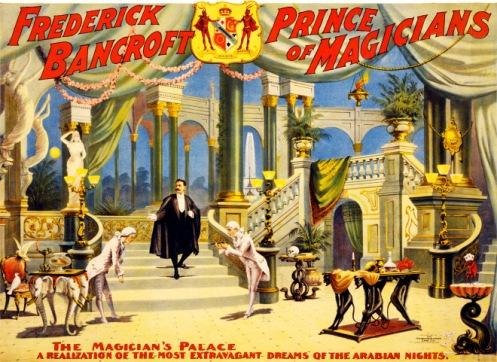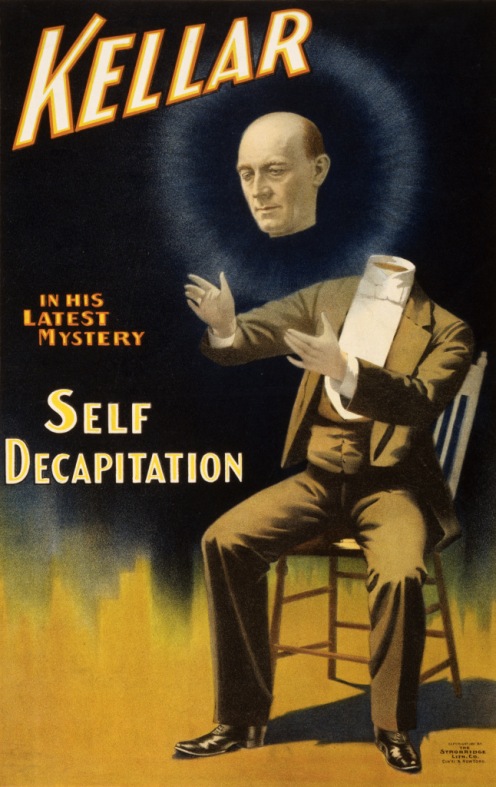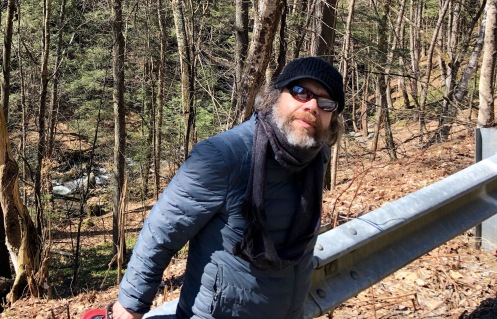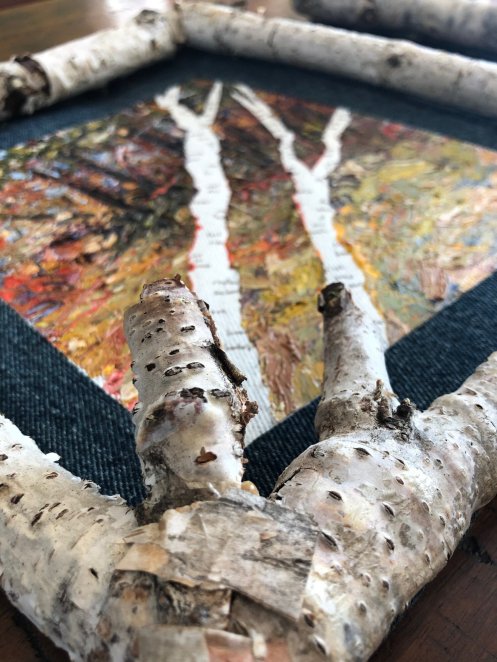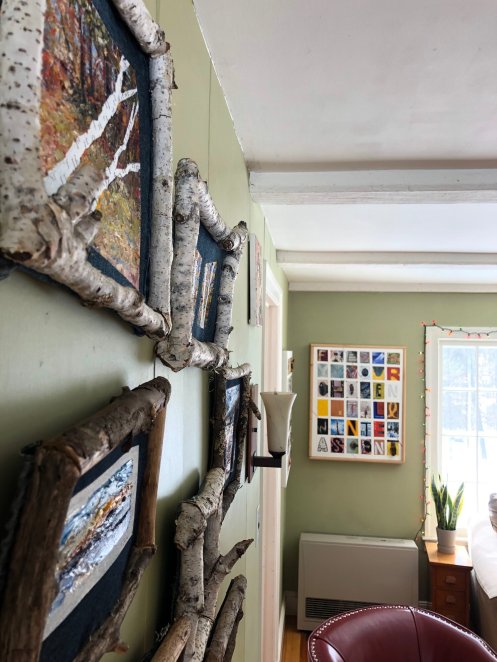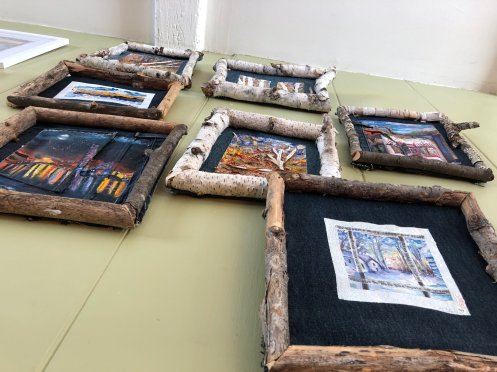Wind projected the warrior faces printed on our dresses into films coming alive on our legs, slouched to one side like tired horses. We were waiting for the train on a “Bad-Idea” platform, miles away from our designated area, where only the plural consciousnesses live—We, the Royal Weeze. We were late and nervous, a sitting brace of ducks in Houdini territory where only the magicians were allowed to be.
We exchanged worried looks on the tea-kettling winds of the platform, souring our eyes on vivid tiles of Kar-Mi the Mysterious taming a crocodile and Vel Mar the Great swallowing swords—nothing like our drab pictotiles, the great AllOfUs holding hands with Infinity. And then over the whirring hum of our dread came footsteps. A pert click clack that could only mean a magician was coming to join us on the platform.
We cinched up our faces and puckered our eyes to…
View original post 735 more words
Here are 10 Amazing Examples of Flash Creative Nonfiction (we’ve recently enjoyed)
Creative nonfiction or cnf is the art of truth telling. Flash cnf is the same thing at blender velocities. Here is a list of some of the best we’ve had the pleasure of reading.
1. uzodinma okehi
Pure Fantasy – Atticus Review
The kickboxing class is supposed to be my training for The Movie, though by this point it’s all become little more than pure fantasy.I can’t blame Abdul. To be honest. Put it another way, Abdul, messing around, his video camera to the Hi-8 cassettes stacked on the TV, run it through a co-axl, and I’m watching water droplets on a spiderweb, 15-minute sunsets, and so on.
In “Pure Fantasy,” Uzodinma Okehi details the death of creative inspiration. If you’ve been wondering why your dreams for artistic greatness are never realized, Okehi has a theory. It seems that the answer has something to do with the “half life effect…of Iowa City” and that insidious soul killer, Nintendo N64. We admire the way this writer plunges us into a moment with a story inside it. In just under 700 words, Okehi reveals a friendship, a collaborative vision born within it, and the slow fade of both into the dull monotony of the everyday. Okehi’s final description of the “rogue’s gallery of fools” in kickboxing is artful in its brevity, equal parts hilarity and disappointment. This is a great piece with powerful resonances beyond the “merely autobiographical.”
2. Frenci Nguyen
The point of some flash CNF seems to be the worst moment ever enshrined on the page for others to witness. It can be gruelingly confessional. Extremes cannot be passed off as fictions, as happening to nobody ever. When writers blend wisdom with confessional intensities, a textual form of justice—or at least the possibility for a full hearing opens up on the page. We feel ourselves falling vicariously into different roles of this all too familiar scene for students of color on college campuses around the United States. Other pieces we found worthy of second readings here include “Election Day” by Ashley Cowger, “Inside My Mother’s Mouth” by AM Roselli, and “Persuasion” by Ona Gritz —but be fore-flashed…though they are quick reads, they’re in no way light or easy. Pain sprints. It moves in flashes. Much slower is understanding, a lolly gag from way back who wears concrete shoes.
Read the rest here:
https://www.michaelandsarachaney.com/blog/2020/8/17/best-form-poetry

We sit at a window. One with pen. The other, pastels. We reflect. Together.
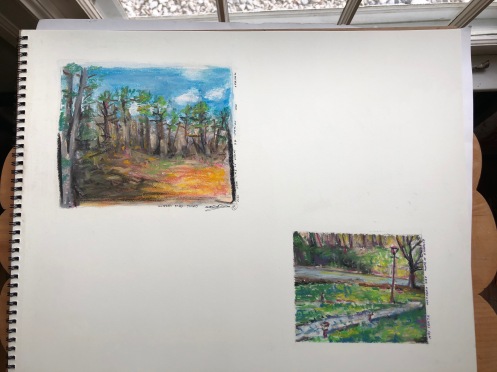
The gaps are for poems (and verbal visuals) to be added later.
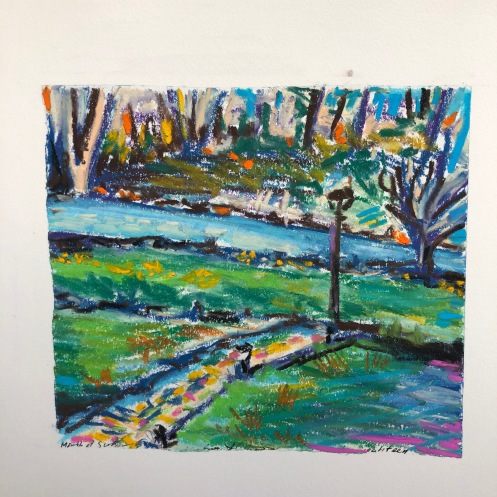
These are part of a project we call “month of sundays.” We sit together every Sunday, to look out of the same window.
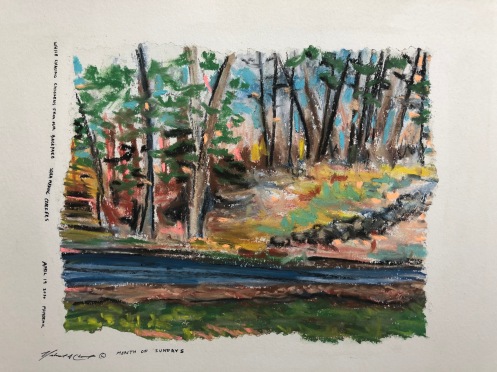
We do it for a month of Sundays or for thirty Sundays.
Having done it for some years now, we feel it has provided us with inspiration and preparation for life in times of pandemic.
Here are ideas for frames that are more artful than they are limiting.
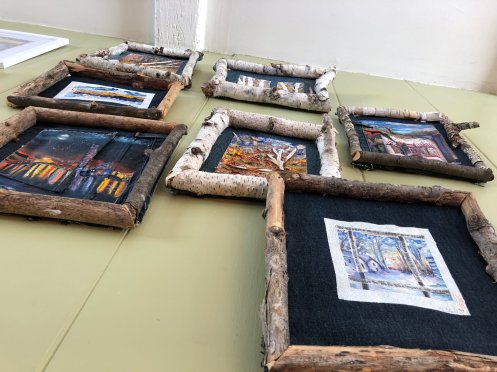
Art looks best when framed. But what is a frame? An ideal border, a frame proposes those parts of an artwork which are deemed, more or less, central. By the fact of the frame being a limiting device, art pushes somewhat against the concept of a frame. Art, like the American poet Walt Whitman, wants to kick down the doors, opening up to the world. Frames say, the art stops here. Art doesn’t want to talk about endings or edges in such simple terms.
With such different intentions and outlooks, It’s strange that art and frames would ever get along at all.

We prefer frames and grounds, which are the surfaces an artist paints on. that agree with art. These artworks are original landscapes. Some are visual poems as well as paintings. The natural materials express freedom of form, both the organic world and its impending limits. The frame co-creates the effect of the view. This is what a frame ought to do.

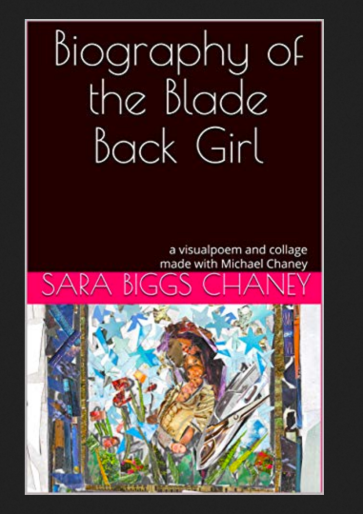
We are thrilled to have our collage published in the form of a small e-book. Admirers can have a copy of the poem that is also a collage, a graphic narrative, and a fairy tale about a woman finding her voice.
Partly published in Redivider and the New Delta Review, originals were exhibited in juried art shows:
Gender in the Balance, August – September 2019 Barrett Art Center, Poughkeepsie NY
The North by Northwest (NXNW) Exhibition July – October 2019. Yellowstone Art Museum, Billings, MT
Get your e-book here:
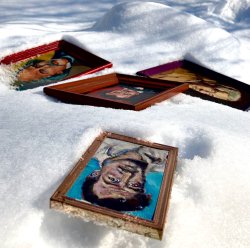
Winter is especially inspiring for the artful and art-minded. Absence of chroma leaves room for the mind to imagine colors impossible to see in June.
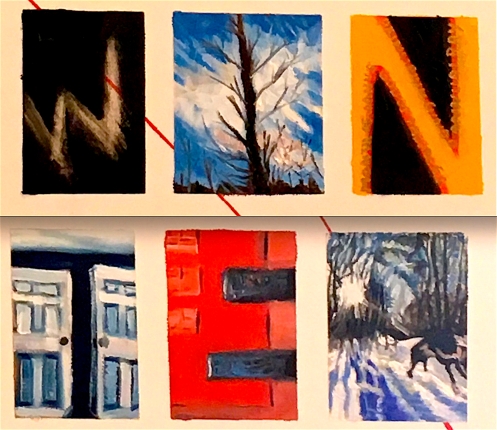
We spend winter looking for view. Pardon the bacon, by the way, the blueberries don’t mind. We’ll hike through our backyard with Vegas in tow, looking for sights as we crunch through the snow.

Sara pauses to see a poem.
And then Vegas smells another volume of poetry in the willows.
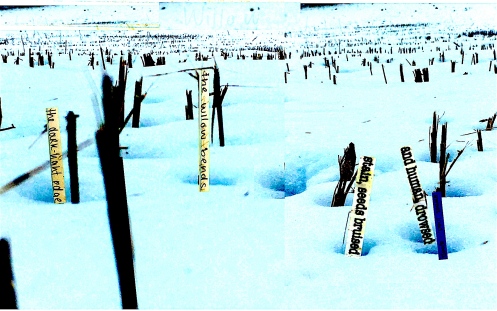
Back inside, we sit with books. Faulkner is there. But we keep a close eye on him.
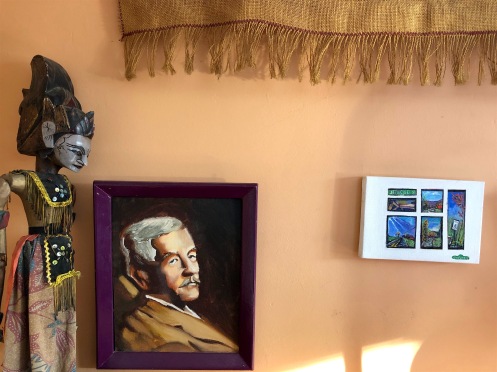
Hemingway is there too. He is orange inside a stuffy old house in winter. Though mini, this Hem has a big head for outside adventures.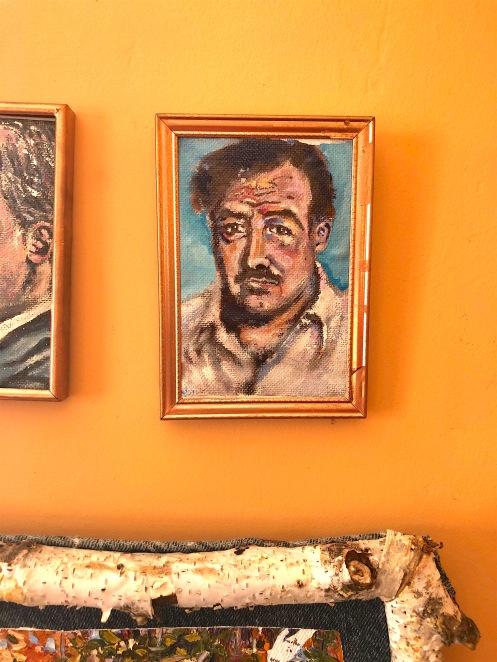
Uh-oh, mini Hem establishes himself against forbears and compeers alike. Harry Bloom, who wrote all the diagnostics on this kind of conflict, would thank Oedipus for Hem’s aggression in the snowball fight that ensued. 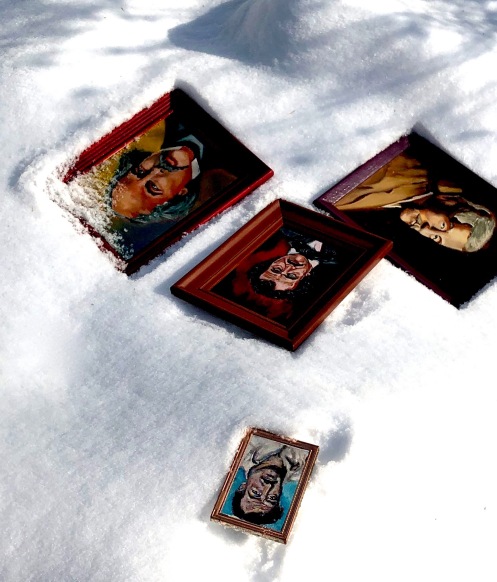
Take that Hawthorne!

Here he is, King of the Mountain. 
We’re not sure we can keep this one on our wall for long. Perhaps, you’d fare better. If you’d like to have your own adventures with one of these roguish authors, apply here.
https://www.etsy.com/shop/MichaelChaneyArt
and don’t forget to follow us on Twitter @Mrmaxchi Michael Chaney Art
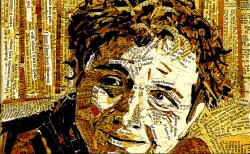
Sara Biggs Chaney and I have been busily working with papery word fragments, piecing them together, layer upon layer, until greeting a face.
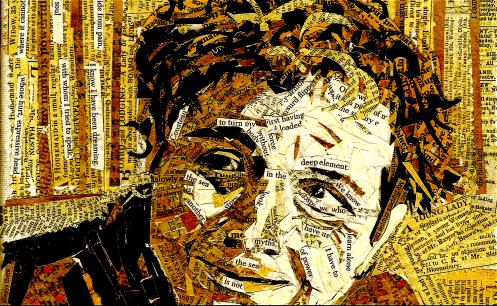
Adrienne Rich
Adrienne Rich, Gwendolyn Brooks, Lucille Clifton, Elizabeth Bishop, and HD. These are poets we admire. Their words forge textures on the page. Each one is an 8×10 artwork collage ready to brighten any room. The beauty of words and faces, of fragments and figures, shines through the glue in each portrait.
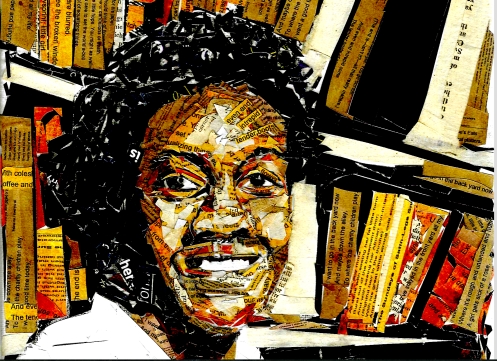
Gwendolyn Brooks
You’ll notice how the titles of the books in the re-worked photo above are comprised of more lines from Brooks’ poetry…. And by the way, for now, our favorite adhesive is liquitex matte glaze.
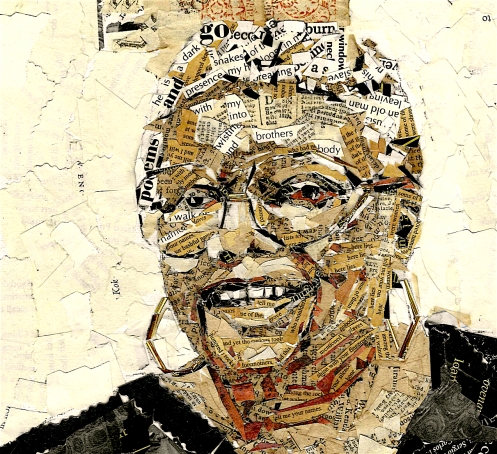
Lucille Clifton
There are stiffer papers used in the Clifton collage above. Collage challenges the camera and our eyes to see things normally perceived through touch–like contour, edge, weight.
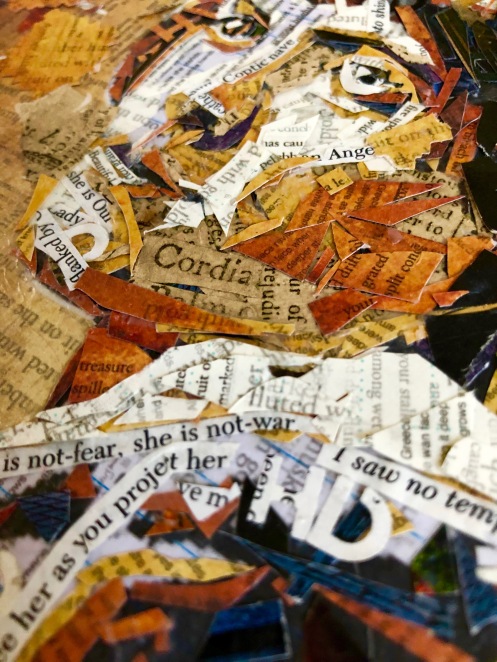
HD
We selected our subjects for the force of their original poetry. And we wanted to memorialize great poets.
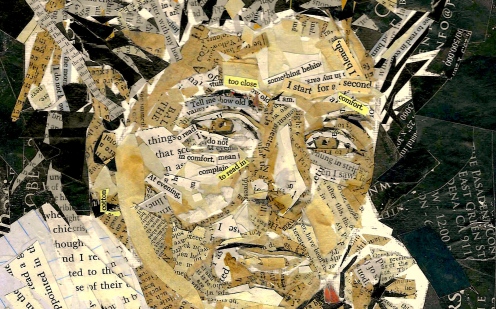
Elizabeth Bishop
We prefer mod podge and home made mixtures for other projects, but these were perfect for the matte glaze. The paper and words are the focus of these portraits.
We hope you like them.
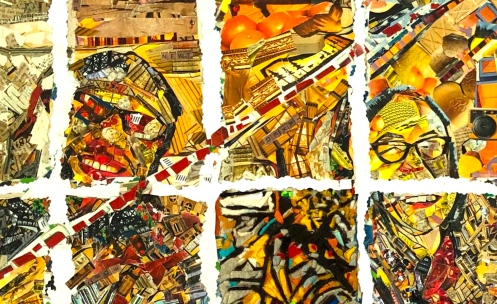
Michael and Sara
To purchase one of these portraits or to see more, visit the shop
https://www.etsy.com/shop/MichaelChaneyArt
We are pleased to have a visual poem up at Florida Review online or Aquifier with Sara Biggs Chaney
 Season Cluster floridareview.cah.ucf.edu/article/season
Season Cluster floridareview.cah.ucf.edu/article/season


